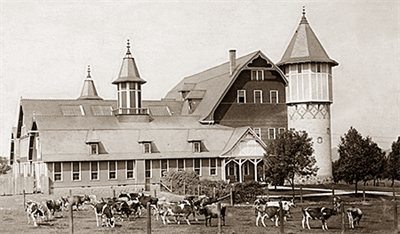
In late October 1925, one month before the legal incorporation of the Wisconsin Alumni Research Foundation, Alfred J. Glover, the influential editor of the trade magazine Hoard’s Dairyman, challenged the foundation’s right to exist.1 Earlier in 1925, Harry Steenbock had conceived the idea for WARF as a vehicle to license his vitamin D patents and use the royalties to support research at the University of Wisconsin.
Glover, a persuasive advocate for dairy farmers and a booster of the university’s Agricultural Research Station, worried that an independent foundation of this sort would use public property for private ends and, in the process, undermine Wisconsin’s most important industry.
In an attempt to assuage those fears, Harry L. Russell, dean of UW’s College of Agriculture and later WARF’s first managing director, promised that the foundation’s alumni trustees would “follow where truth leads.” In reply, Glover asked, “are we doing this when we patent new truths and place them in the hands of a corporation to control?” That question kicked off a long debate among Wisconsin’s industry leaders, government officials and university administrators over who should control the products of university research and how the proceeds should be distributed.
Complicating matters further, Russell left the country earlier that fall on a months-long business trip through Asia.2 As a result, Glover’s letter first landed on the desk of Assistant Dean F.B. Morrison, who had reasons of his own for being skeptical of WARF. Knowing that Russell did not share his doubts, Morrison at first chose to keep quiet until the dean could respond.3 But this cautious approach backfired. After WARF’s members ratified articles of organization on November 23, Morrison decided to inform Steenbock about Glover’s objections. Steenbock responded by growing “violently angry,” as Morrison put it, over not being told “as soon as [the letter] was received.”4 After that, Morrison became “very much excited over the matter,” in the words of Graduate School Dean Charles Sumner Slichter, which in turn “stirred up” University President Glenn Frank and several other prominent voices in the dairy industry.5
Thus, by the end of the year, what began as a brief but pointed inquiry from Glover had agitated Wisconsin business leaders, unsettled university administrators and inflamed the legendary temper of Harry Steenbock. The controversy continued to simmer until the middle of January when a packet of letters, delayed in part by the impending Chinese civil war, caught up to Russell in Nanking. Besides varying accounts of who had remained calm and who had thrown a fit, the correspondence captured a contentious back and forth about the ethics of patenting and licensing academic research.
On the more critical end, Glover’s doubts about a private corporation led him to oppose the patenting of university research altogether. Likewise, Morrison argued that a board of alumni “would naturally have the capitalistic point of view” and could not be trusted to act in the best interests of the university. As a counterargument, Steenbock rejected the view that university administrators must be “the guardians of the principles of research.”6 Instead, he maintained, as he had from the beginning, that only an independent foundation could preserve the academic freedom of individual inventors while shielding the university from the financial and ethical risks of commercializing science.
Another WARF advocate, Graduate Dean Slichter, worried that the argument had stalled the decision-making process. Differences of opinion would sort in time, he told Russell, but WARF had been incorporated weeks ago. Considering the public health potential of Steenbock’s discovery, moving forward with alacrity was “almost a duty to humanity.” Russell agreed. Writing from a Nanking hospital bed while recovering from “the grippe,” he told Glover and Morrison that “the whole purpose [of WARF] has been to create a workable legal entity” well-suited for “business efficiency, and yet embued [sic] with the ideals of university and public service.”Rather than “a private corporation in the ordinary sense of the word,” WARF would be “a quasi-public foundation” designed to keep Wisconsin’s industry and research competitive with elite private universities and oleomargarine manufacturers.7 8
These letters from China did little to change the minds of Glover and Morrison, nor did they end the debate over patenting. But Russell’s intervention, combined with Slichter’s persistent prodding back in Wisconsin, prevented bureaucratic inertia from taking hold. The following May, with disagreements still lingering, WARF’s alumni membership invited Steenbock, Morrison, Slichter and President Frank to voice their opinions at the foundation’s inaugural board meeting. While the trustees wielded final authority over the foundation’s course of action, the policies they would hammer out over the following years came to reflect, respond to and adapt the diverse opinions uncovered by the Hoard’s Dairyman controversy.
Therefore, in the final analysis, we should not understand WARF as springing, fully formed, from the brain of any one individual. Instead, its unique character arose out of a negotiation of interests between businessmen, alumni and university personnel. To find out how that negotiation evolved, and how WARF won over the dairy industry, come back next month for the continuation of our story.
Kevin Walters
Historian-in-Residence
2015